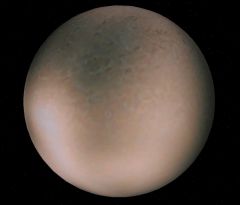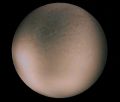Difference between revisions of "Charon"
(Added category.) |
(Added content.) |
||
| Line 1: | Line 1: | ||
| − | Charon is the largest natural satellite of [[Pluto]]. | + | {| cellpadding="2" cellspacing="0" style="margin:25px 0 0 10px; border:3px solid lightsteelblue;width:250px; font-size:90%; font-family:'Arial','Helvetica'; float: right; clear: right;"Pluto in Orbiter" |
| + | !bgcolor="lightsteelblue" colspan="2" align="center" |Charon | ||
| + | |- | ||
| + | |colspan="2" align="center"|[[Image:Charon-plutopackzip-Orbiter2003P2.jpg|Charon|240px]] | ||
| + | |- | ||
| + | |colspan="2" align="center"|'''Charon from ''pluto_pack.zip'' in Orbiter 2003P2''' | ||
| + | |- | ||
| + | !bgcolor="lightsteelblue" colspan="2"|Designation | ||
| + | |- | ||
| + | |Name||align="right"|Charon | ||
| + | |- | ||
| + | |width="30%"|Reference body||align="right" width="30%"|134340 Pluto | ||
| + | |- | ||
| + | |width="30%"|Number of satellites||align="right" width="30%"| | ||
| + | |- | ||
| + | !bgcolor="lightsteelblue" colspan="2"|Planetary mean orbits | ||
| + | |- | ||
| + | |width="30%"|Epoch||align="right" width="50%"|J2000 (1 January 2000) | ||
| + | |- | ||
| + | |width="30%"|Semimajor axis (a)||align="right" width="50%"|19 600 000 m | ||
| + | |- | ||
| + | |width="30%"|Eccentricity (e)||align="right" width="30%"|0.0 | ||
| + | |- | ||
| + | |width="30%"|Inclination (i)||align="right" width="30%"|99° <br> (1.72787596 radian) | ||
| + | |- | ||
| + | |width="30%"|Longitude of the ascending node (LAN, ☊)||align="right" width="30%"|0° <br> (0 radian) | ||
| + | |- | ||
| + | |width="30%"|Longitude of periapsis (ϖ)||align="right" width="30%"|114.591559° <br> (2 radian) | ||
| + | |- | ||
| + | |width="30%"|Mean longitude (L)||align="right" width="30%"|0° <br> (0 radian) | ||
| + | |- | ||
| + | !bgcolor="lightsteelblue" colspan="2"|Selected physical parameters | ||
| + | |- | ||
| + | |width="30%"|Mean radius||align="right" width="30%"|593000 m | ||
| + | |- | ||
| + | |width="30%"|Mass||align="right" width="30%"|3.3×10<sup>21</sup> kg | ||
| + | |- | ||
| + | |width="30%"|Sidereal rotation period||align="right" width="30%"|-551858 sec (153.294 hours) | ||
| + | |- | ||
| + | |width="30%"|SidRotOffset||align="right" width="30%"|0 | ||
| + | |- | ||
| + | |width="30%"|Obliquity||align="right" width="30%"|0° (0 radian) | ||
| + | |- | ||
| + | |width="30%"|Note||align="right" width="30%"|*Elements given are from Charon.cfg (pluto_pack.zip) | ||
| + | |} | ||
| + | |||
| + | Charon is the largest natural satellite of [[Pluto]]. Its radius is about half that of Pluto, and their barycentre lies outside both objects. This is a common definition of a binary object, leading some astronomers to consider them a [[w:Double planet|double dwarf planet]]. | ||
| + | |||
| + | Charon was discovered in 1978 by [[w:James W. Christy|James W Christy]]. | ||
From the discovery of [[Nix]] and [[Hydra]], it was possible to estimate Charon's mass as roughly 10% that of Pluto. This implies it's approximately 45% ice, thought mostly to be water ice. | From the discovery of [[Nix]] and [[Hydra]], it was possible to estimate Charon's mass as roughly 10% that of Pluto. This implies it's approximately 45% ice, thought mostly to be water ice. | ||
| + | |||
| + | == Charon in Orbiter == | ||
| + | Charon was introduced to Orbiter with the release of ''pluto_pack.zip'' in July 2004. | ||
| + | |||
| + | {| class="wikitable" style="text-align: center" | ||
| + | |colspan="8"|<center>'''Orbiter versions and add-ons which include Charon'''</center> | ||
| + | |- | ||
| + | !Add-on!!Source!!Version!!Author!!Type!!Release Date!!Compatibility!!Wiki article | ||
| + | |- | ||
| + | |[https://library.avsim.net/esearch.php?DLID=&Name=&FileName=pluto_pack.zip&Author=&CatID=root Pluto Pack]||AVSIM||||CharlotMan||Scenery||17 July 2004|||| | ||
| + | |} | ||
| + | |||
| + | == Gallery == | ||
| + | <gallery> | ||
| + | Charon-plutopackzip-Orbiter2003P2.jpg|<center>Charon from ''pluto_pack.zip'' in Orbiter 2003P2</center> | ||
| + | Charon in True Color - High-Res.jpg|<center>Charon imaged by [[w:New Horizons|New Horizons spacecraft]] in July 2015<br>from Wikimedia Commons</center> | ||
| + | First Color Animated Images show Pluto and its Moon Charon.gif|<center>first color animation of the orbits of Pluto and Charon<br>from Wikimedia Commons</center> | ||
| + | </gallery> | ||
| + | |||
{{Nsat-Stub}} | {{Nsat-Stub}} | ||
{{PlutoMoons}} | {{PlutoMoons}} | ||
| + | {{SolarSystem}} | ||
[[Category: Articles]] | [[Category: Articles]] | ||
| + | [[Category:Solar System]] | ||
| + | [[Category:Celestial bodies]] | ||
| + | [[Category:Natural satellites]] | ||
Revision as of 03:21, 10 September 2024
Charon is the largest natural satellite of Pluto. Its radius is about half that of Pluto, and their barycentre lies outside both objects. This is a common definition of a binary object, leading some astronomers to consider them a double dwarf planet.
Charon was discovered in 1978 by James W Christy.
From the discovery of Nix and Hydra, it was possible to estimate Charon's mass as roughly 10% that of Pluto. This implies it's approximately 45% ice, thought mostly to be water ice.
Charon in Orbiter
Charon was introduced to Orbiter with the release of pluto_pack.zip in July 2004.
| Add-on | Source | Version | Author | Type | Release Date | Compatibility | Wiki article |
|---|---|---|---|---|---|---|---|
| Pluto Pack | AVSIM | CharlotMan | Scenery | 17 July 2004 | |||
Gallery
Charon imaged by New Horizons spacecraft in July 2015
from Wikimedia Commons
 | This natural satellite related article is a stub. You can help Orbiterwiki by expanding it.
| ||||||||||||



